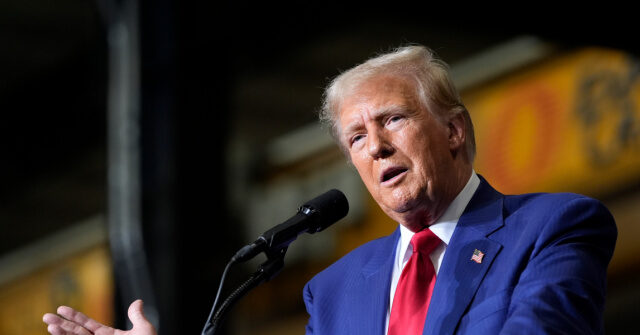
The former president will call for cuts to regulations standing in the way of cheaper energy and housing.
The post Trump To Unveil Bold Economic Plan To ‘Make America Affordable Again’ appeared first on Breitbart.

In a high-profile speech set for Thursday at the Economic Club of New York, Donald Trump will lay out a comprehensive economic vision under the banner of “Make America Affordable Again,” aimed at restoring affordability and driving down the high cost of living that many Americans have faced under the Biden-Harris administration.
Trump’s plan focuses on cutting government waste, scaling back regulatory overreach, and unleashing domestic energy production—all pillars he sees as essential to revitalizing the economy.
A centerpiece of Trump’s agenda is the creation of a government efficiency commission, an idea suggested by tech entrepreneur Elon Musk, which would conduct a full audit of the federal government to identify waste, fraud, and inefficiencies. Trump’s goal, according to people familiar with the speech, is to streamline government operations and curb inflation by reducing unnecessary spending. The proposal has already garnered attention, with Musk publicly backing it as a way to rein in bloated bureaucracy.
The news that Trump would endorse the Musk commission was first reported by the Wall Street Journal.
For Trump, the speech serves as a clear contrast to the Biden-Harris economic policies, which he argues have only made life more expensive for American families. Polls show Trump holding a notable lead over Vice President Kamala Harris on handling economic issues—a reflection of growing frustration with rising costs and the economic challenges of recent years. By leaning into his record of deregulation and fiscal restraint, Trump aims to present himself as the leader who can make the American economy affordable once again.
Trump’s plan also includes a strong push for deregulation, focusing specifically on the housing and energy sectors. By cutting back on regulations and opening federal land for large-scale housing development, Trump hopes to lower housing costs, a pressing issue for many Americans. His approach to energy, which centers on fast-tracking approvals for drilling and pipelines, is designed to reduce energy prices dramatically—a goal that reflects his longstanding emphasis on energy independence and affordability.
Another key element of Trump’s “Make America Affordable Again” plan is his promise to rescind unspent funds from the Biden administration’s Inflation Reduction Act, which he has consistently criticized for contributing to government overreach and failing to deliver real relief to Americans. By targeting unused funds tied to programs such as the IRS, Trump is betting that fiscal conservatives will rally behind his effort to rein in excessive spending and bureaucracy.
Trump is also expected to reiterate his support for “smart tariffs” on imports, particularly from China, as a way to bolster domestic manufacturing. Unlike critics who warn that tariffs could raise consumer prices, Trump views them as a vital tool for protecting American industry, keeping the economy competitive, and opening markets around the globe to U.S. companies. His campaign maintains that tariffs will help reduce inflation by encouraging domestic production—a central theme of his economic agenda.
“Smart tariffs will not create inflation, they will combat inflation,” Trump plans to say, according to the Wall Street Journal. “A combination of fair trade, tax cuts, regulatory cuts and energy abundance will allow us to produce more goods, better and cheaper right here in the U.S.A.”
Vice President Kamala Harris, for her part, has been working to distance herself from the policies of the Biden-Harris administration, which many Americans see as responsible for skyrocketing inflation and higher costs of living. Trump is expected to remind voters that Harris cast tie-breaking votes for many of the administration’s key spending measures.
Trump’s “Make America Affordable Again” initiative is likely to resonate with voters who are feeling the pressure of rising costs. With its emphasis on cutting regulations, boosting domestic production, and reducing wasteful government spending, Trump’s plan offers a clear contrast to the economic policies of the current administration.






